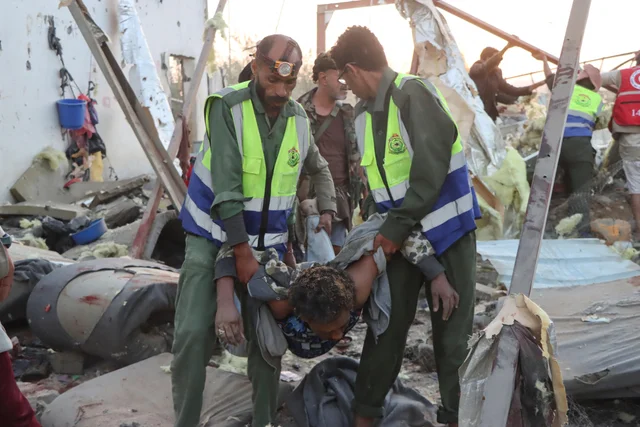SAADA, Yemen — At least 68 African migrants were killed and another 47 critically wounded after a United States airstrike reportedly targeted a detention center in Yemen’s Houthi-controlled Saada province, according to Houthi-affiliated media outlets.

The devastating strike on Sunday night left the facility in ruins, with harrowing footage aired by Houthi-run Al Masirah TV showing mangled bodies beneath the rubble. Most of the victims were migrants from African nations who had been detained at the center, which was reportedly housing 115 individuals at the time of the attack.
There was no immediate response from the United States military regarding the incident. However, the reported bombing came just hours after US Central Command (Centcom) announced it had conducted over 800 airstrikes against Houthi targets since President Donald Trump ordered a heightened military campaign against the Iran-backed group on March 15.
Centcom said its strikes have eliminated “hundreds of Houthi fighters and numerous leaders,” particularly those involved in missile and drone operations. The US has intensified its military actions in Yemen in recent weeks, aiming to cripple the Houthis’ ability to disrupt international shipping lanes and to degrade their operational capabilities.
Despite US assurances that its campaign is focused on military targets, Houthi authorities claim civilians have borne the brunt of the attacks. They contend that dozens of civilian casualties have occurred, though they have provided minimal confirmation of deaths among Houthi combatants.
Sunday’s strike has amplified concerns from humanitarian groups already alarmed by Yemen’s dire situation. According to the International Organization for Migration (IOM), the conflict has not deterred desperate migrants — primarily from the Horn of Africa — from crossing the treacherous Red Sea in hopes of finding work in neighboring Saudi Arabia. Many instead find themselves trapped in detention centers, facing exploitation, violence, and the hazards of ongoing conflict.
The IOM reports that nearly 60,900 migrants have arrived in Yemen in 2024 alone, despite the extreme risks. “Migrants often arrive with no means to survive and face severe human rights violations,” the organization said in a statement earlier this month.

Sunday’s tragedy follows another major incident earlier in April, when Houthi officials claimed that a US airstrike on the Ras Isa oil terminal on the Red Sea killed at least 74 civilians and wounded 171 others. Houthis have labeled the strikes “war crimes,” while Centcom maintains that attacks on Ras Isa were necessary to disrupt the Houthis’ revenue streams funding terrorism.
“The destruction of Ras Isa will severely impact the Houthis’ ability to conduct operations and finance their terror activities,” Centcom said following that strike.
The Trump administration, returning to a hardline stance against the Houthis, has vowed relentless pressure. After taking office in January 2025, Trump redesignated the Houthis as a “Foreign Terrorist Organization,” a classification the Biden administration had previously revoked in an effort to ease Yemen’s humanitarian suffering.
On Sunday, Centcom reiterated that the US mission would continue: “We will ratchet up the pressure until our objectives are met, which remain the restoration of freedom of navigation and American deterrence in the region.”
The Houthis, however, remain defiant. Since late 2023, they have launched dozens of attacks against merchant vessels traversing the Red Sea and the Gulf of Aden, claiming these strikes are acts of solidarity with Palestinians amid the Israel-Hamas conflict. Despite their assertions that they only target ships linked to Israel, the US, or the UK, indiscriminate attacks have killed four sailors, sunk two vessels, and severely disrupted international shipping.
Western efforts to secure these critical waterways — including the deployment of warships and multiple retaliatory airstrikes — have so far failed to deter Houthi aggression.
The backdrop to these developments is Yemen’s protracted civil war, now stretching into its second decade. The conflict erupted in earnest when the Houthis seized the capital, Sanaa, and much of the country’s northwest from the internationally recognized government in 2014. A Saudi-led coalition, backed by the United States, intervened militarily in 2015 in an attempt to restore the deposed government’s authority.
Since then, the fighting has claimed more than 150,000 lives, according to estimates from international monitors. The United Nations reports that roughly 4.8 million Yemenis remain displaced, while 19.5 million — more than half the population — urgently require humanitarian assistance.
The latest tragedy underscores the profound dangers facing migrants and civilians trapped in Yemen’s ongoing war.
As of Monday, search and recovery efforts continued at the destroyed detention center, with authorities warning that the death toll could rise as critically injured survivors fight for their lives in overwhelmed local hospitals.
The US military has yet to address the specific allegations concerning the Saada strike, but the incident threatens to further inflame tensions in a conflict that shows little sign of abating.



